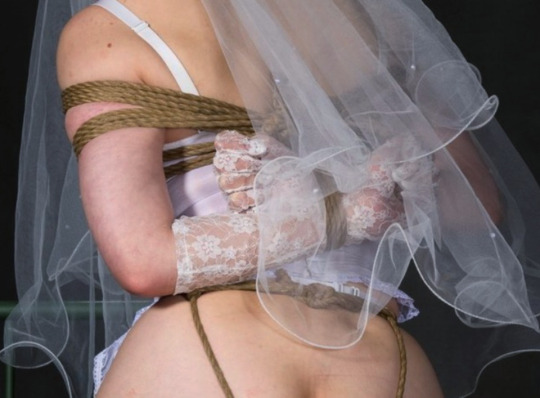#futures
Text
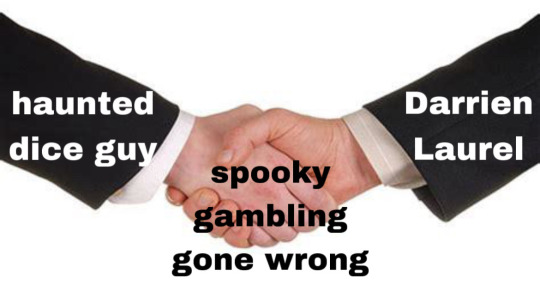
Play stupid games, win stupid prizes 🎲📱
#the magnus protocol#tmagp#the magnus archives#tma#tmagp spoilers#darrien laurel#tmagp 13#futures#tmagp 9#rolling with it#neo queen serenity’s memes#the magnus protocol spoilers
519 notes
·
View notes
Text
Anyways,the reason why we no longer have an agreed upon aesthetic of what the future should look like isn't because of apocalypticism; it's because modernism--which during the nineteenth and twentiety centuries, seemed utterly inexorable, like a train going in only one direction, foreclosing all other possibilities--is basically dead. Like, if you look at the stereotypical "future" in 20th century sci-fi, it was basically just the same thing that they were doing at the time, only Moreso. *Taller* skyscrapers! Personal *aircraft* instead of personal automobiles! Rockets to the moon, just like getting on a jumbo jet to Amsterdam! And anyway, we've reached the end of that--we're past even the Cyberpunk version of "what the future should look like"--and because there's no obvious "right" answer, no one can agree on what it should be.
Anyways, for my money,the future needs to look like a garden.
743 notes
·
View notes
Link
Solarpunk is both pragmatic and utopian. It has to incorporate the latter because that allows us to push the boundaries of what is considered possible. At the same time, being pragmatic is a way of bringing back the reader (or listener) to the present after temporarily escaping into a Solarpunk story. For example, a Solarpunk story set in Gaza in the year 2040 could imagine climate change-related challenges that the Palestinians there would be facing then, and imagine ways of solving them. This would be told in a story in a setting with its own specificity which differs from, say, a story set in Paris in that same year. A Solarpunk story set in Gaza 2040 would therefore have to respect the specific history of that city while also trying to imagine what it could look like free of colonialism, apartheid, patriarchy and other forms of oppression. In that world, are there still two nation-states (Israel and Egypt) restricting the freedom of movement of Palestinians in Gaza? What is the access to resources such as water like? Could permablitzing be one tool against societal atomization brought about by an oppressive state? What are the heatwaves like? Are they dealing with droughts? Is the Mediterranean a source of recreation and abundance, or an intimidating body of water rendered more dangerous by global warming? How are relations with their neighbors?
Fantastic long read on Solarpunk in New Lines Magazine from The Fire These Times podcast host Joey Ayoub
#solarpunk#solar punk#t.x. watson#Joey Ayoub#The Fire These Times#podcast#sci-fi#permaculture#futures#cyberpunk#utopia#climate change#climate crisis
410 notes
·
View notes
Text
And the penal colony was to remain a viable alternative to the penitentiary, not only in nineteenth-century Britain, but also in twentieth-century France [...]. But what might it mean to have a rigorous and distant form of imprisonment, located in a colony and continuing until the mid–twentieth century? [...]
---
French Guiana emerged as an early favorite for the placement of a French penal colony. [...] Daniel Lescallier, [...] authored a work entitled [...] (Exposition of the means by which to develop French Guiana). In it he points to the example the British have set in exporting offenders to the colonies [...]. Louis-Napoleon, still serving in the capacity of president of the republic, threw his weight behind [...] the exile of criminals as well as political dissidents. “It seems possible to me,” he declared near the end of 1850, “to render the punishment of hard labor more efficient, more moralizing, less expensive [...], by using it to advance French colonization.” [...] The era of the French penal colony was now open; the new French Empire had begun its Botany Bay, even as the British original [penal colony in Australia] wound to a close. [...] The double logic of the British system also drives the French imagination; proposals alternatively concentrate on a desire to punish criminals and rid the Metropole of their presence, on the one hand, and a hope of furthering the work of colonial expansion and economic progress, on the other. Within this logic the focus shifts between the need to colonize, the need to punish [...].
In the case of France, it shimmers with colonial fantasy, allowing future Australias to emerge on tropical horizons. [...] [T]he penal colony requires location. The specificity of the site matters; it is the very place that is to enact punishment [...]. The penal colony is in essence a geographic technique [...]. But despite frequent outcries and sensational reports, the French Guiana penal establishment continued to exist through the end of World War II. [...] As geography itself becomes a technique of isolation, the French penal experiment in Guiana threatens further ordeals implicit in separation from all that is civilized. [...] In sensational accounts these tropics incessantly punish [...]: “Fever and dysentery get every man! Clouds of buzzing mosquitoes and fire ants sting your aching body while you labor [...].” As the commandant of the bagne would inform convicts on their arrival, “The real guards here are the jungle and the sea.” [...] Many of the prisoners, after all, were from urban environments [...]. The terror of Devil's Island takes shape amid metaphoric invocations of the jungle and of the savage [...].
---
For those in Metropolitan France the penal colony served as a hidden punishment, a distant if graphic terror, retaining elements of torture out of public view. Yet it retained a veneer of reformation, for the convicts were still told to “make a new life for themselves.” In addition, shipping convicts away from France in the name of colonization cloaked their punishment in the robes of the “civilizing” mission: they would be part of an effort to build a greater France, to develop Guiana, and to integrate it into a Franco-world system. At the same time the bagne underscored that resistance to the humane norms of France could lead to decivilization and exile in the wilderness. [...]
---
For those sent to French Guiana, however, the penal colony served directly as a public display, a constant reminder of the operations of justice. The convicts were not merely confined but forced to labor on public works. Official executions were performed by that once-humane instrument, the guillotine, but before an audience of convicts and by a fellow convict, far beyond the gates of Paris. A slower execution, that of the “dry guillotine,” the effects of the tropical climate, surrounded the entire process of deportation, reminding the convicts that this punishment could only happen here and not within Metropolitan boundaries. Theirs was a raw and primitive environment, one of torture and deprivation away from the public eye. Against the truth invoked in their conviction -- justice -- lay a suggested truth invoked in their punishment: no longer civilized, they were no longer human.
---
And for those already living in French Guiana, the penal colony also served as a public spectacle, if one not aimed directly at them or of their making. Not only did the proximity of prison life to their own lives parade the power of justice before them in an immediate fashion, but the constant importation of prisoners for this apparatus of punishment emphasized the particularly colonial nature of this power. Uncivilized elements were sent to them; their relation to France was that of a repository for human waste, and acts and punishments deemed unseemly for the homeland could still occur within their boundaries.
In addition, the appropriation of the names “Guyane” and “Cayenne” in myths of the bagne and “Devil's Island” precluded other identities, while burdening the area with a symbolic brand and a historical chain to France. “The bagne,” writes Ian Hammel, “left only a disastrous brand on Guiana.”
Brand here means “trademark” as well as “scar,” indicating purpose, function, and maker.
To be remembered as a penal colony is to be remembered not only as a prison, an exotic place of horror, but also as a colony, the object and product of another. [...] Modernizing France, a convulsive patchwork of provinces, cities, farms, and factories, casts its shadow overseas. [...] The penal colony takes shape at a crucial moment in European colonial understandings of place and labor. Slavery had just been abolished in the French Empire […]. If slavery were at an end, then the crucial question facing the colony was that of finding an alternative source of labor [...], not only in French Guiana, but also throughout colonies built on the plantation model.
---
All text above by: Peter Redfield. Space in the Tropics: From Convicts to Rockets in French Guiana. 2000. [Bold emphasis and some paragraph breaks/contractions added by me. Presented here for commentary, teaching, criticism purposes.]
91 notes
·
View notes
Text
It does kinda annoy me when people say the stock market is just gambling, just astrology-for-men, just a con - it ignores a lot of the interesting, real-world importances of the system.
That’s not to say that there’s not a lot of gambling and conning going on in stocks! - but that’s almost all in the sort-of ‘meta level’ of stocks, in the externalities and intricacies of the stock market itself, rather than what the stocks represent and correspond to. There’s a reason most regulatory agencies ban insider trading, market manipulation, and other cons and gambles that only care about the stocks as arbitrary objects of trade.
As an example of stocks-as-intended, stocks as actually related to material reality and production, we can take the case of the humble Chicken McNugget. Before the McNugget’s introduction in 1983, McDonalds didn’t sell chicken products. They had no connection to the chicken market. Given the vagaries of production, where a bad season, a freak storm, or any number of things could affect agricultural output, and thus the price of agricultural goods, expanding into the chicken market was a risky move. If they can only sell McNuggets to people for five dollars, and the price of chicken suddenly shoots up to four, they might not make as much of a profit (which, for a business like McDonalds, which requires constant expansion and growth, isn’t good) or even make a loss. How did they get around this?
Well, they bought futures stocks. Dumb move, right? Gambling isn’t going to help - it’s random chance. It’d be like spending your country’s treasury on Bitcoin (looking at you, Bukele). Well, not so much. The futures stocks they bought were in soybeans, maize, grains - chickenfeed, in short. A futures stock is, at its most basic, just a contract to buy a certain commodity in the future, but at its current cost, today. The way futures stocks work, if the price of the commodity rises, so does the value of the futures stock. If it falls, so does the futures. It’s equivalent to (but a lot more efficient and less hassle than) literally just buying a bunch of corn and soy at its current price to sell later, at the new price. If the price of chickenfeed went up, and thus the price of chicken went up, then the worse profits (or even loss) from McNuggets would be cancelled out exactly by the gain in value of the futures stocks. If the price of chickenfeed went down, the loss from the futures would be cancelled out by the increased McNugget profits.
In short, it was the specific relationship that these stocks had to material reality, the way they acted as an analogy for a more complicated movement of commodities and materials, that allowed McDonalds to sell chicken at a fixed cost. It was precisely the fact that these stocks were not random gambling, but related to actual production, that made them useful, and allowed for new developments.
942 notes
·
View notes
Text
•[ Creek post-covid ]•


•[ English ]•
HELLOOOOOOO good here I bring you a drawing with them as old people, I almost never draw them like this because originally I did not know how to do it as they say "he who does not risk does not win" and well here you can see how beautiful the babies are.
•[ Español ]•
HOLAAAAA buenas aquí les traigo un dibujo con ellos de viejos, casi nunca los dibujo así por qué originalmente no sabía cómo hacerlo como como dicen " el que no arriesga no gana" y bueno aquí los pueden ver a qué estan bien preciosos los nenes
#south park#sp#tweek tweak#craig tucker#south park post covid#futures#futuro#esposos#viejos#tweek x craig#sp creek#creek#cuarentones#forties
141 notes
·
View notes
Photo




Borrowing Tomorrows - Architectural Concepts
by Darius Greene / Ghost Owl Attic
s6
#Architecture#concept#generative#conceptart#rooms#room#room ideas#interior design#design#ai#midj junks#sketch#free range palaces#timelines#futures#pasts#ghostowlattic#dariusgreene#otherworldly#fantasy#mj#midjourney#art#myart#trash#ideas
370 notes
·
View notes
Text
I'm on the cliff of myself & these aren't wings, they're futures.
Ocean Vuong, Beautiful Short Loser
#Ocean Vuong#Time is a Mother#Beautiful Short Loser#wings#futures#Vietnamese literature#poetry#poetry quotes#quotes#quotes blog#literary quotes#literature quotes#literature#book quotes#books#words#text#LGBTQ literature#queer literature#queer poetry#BIPOC author
19 notes
·
View notes
Video
youtube
Jimmy Eat World - 23
I won't always love what I'll never have
I won't always live in my regrets
7 notes
·
View notes
Text
Just Want You To Be Happy - Chris Evans POV fan fiction

Summary: Y/N always focused on helping Chris with his career/ life bc he makes her happy but she didn’t know what job she wanted for her life and Chris helps her figure out what job would fit her because he wants his girl to be happy
Warnings: fluff, mentions of overthinking and anxiety and depression.. Let me know if I forget anything
It was like any other day where Y/N was helping me read lines for a movie or helping me figure out what to wear to a red carpet event and we were having fun reading lines and goofing off but I noticed something was off with her today and I was worried about my favorite girl.
I said “Hey baby you ok? You seem a bit quiet today.”
Y/N looked over at me while writing notes for the upcoming trip and put down the notepad and gave me a smile
She said “Yea I’m ok Chris, why do you ask?”
I softly rubbed her leg and said “if there’s anything you wanna talk about you know you can tell me anything I’m here for you.”
I could tell she had a lot on her mind and I hated seeing her feel stressed and I know she doesn’t wanna bother me with anything.
Y/N took a deep breath and said “I just don’t.. I don’t know what job I wanna have as a career you know? I never know what would be a good fit for me..”
I said “well what really interests you sweetheart? What makes you happy?”
She smiled brightly and said “you do Chris.”
I blushed and kissed her cheek and said “this is why I love you honey.”
Before we could continue some of my nieces and nephews ran into the room and sat by Y/N and I loved watching her interact with them and that made me think, she loves kids!
I grabbed my laptop and got excited and said “babe I know what job you would be perfect for!”
Y/N was playing with my niece and looked over at me and asked “Yea? What kind of job Chris?”
I said “you should work at a daycare center you love kids and I know they absolutely love you.”
Y/N smiled while crying happy tears and hugged me and I hugged her back tight.
Y/N said “Thank you so much honey this means so much to me that you’re helping me with this but.. are you sure you’d be ok with me doing this?”
I looked at her and moved some loose strands of hair away from her face and said “baby, I just want you to be happy, I know how much this means to you that’s what matters to me, I love you.”
Y/N smiled and leaned in to kiss me and said “I love you too Chris and again thank you so much, I guess I was always too nervous that I wouldn’t be good enough to work at a daycare place..”
I said “honey hey, they would be lucky to have such a wonderful woman working there who loves kids and has such a big heart, trust me.”
Y/N smiled and said “you’re so good to me Chris I don’t know what I’d do without you.”
I hugged her and said “I’m not going anywhere honey I love you so much.”
I’m not very good at writing fan fictions but I hope you all enjoy this one xx I thought this was a cute idea ☺️
#chris evans#fluff#chris evans fan fiction#chris evans x fem! reader#chris evans imagines#chris evans angst#chris evans fluff#comfort#futures#happiness
87 notes
·
View notes
Text
TMAGP 13 connections/theories?
Metallic chittering; maybe a machine? Insectoid design?
1a. What is this metallic chittering thing?
1b. Darrien attacked in a hospital by a weird, mechanical thing. He could see/hear it, as proven by how he called for a nurse, so would be visible like Mr. Bonzo/Needles
1c. Who is the "external" Lena needed Gwen to visit? Could it be this machine or someone "in charge" of this machine?
2. Darrien's incident was live(?)/not read out by Norris or Chester; how will OIAR staff become aware of it in later episodes?
3. Zorrotrade/self-mutilation for money; could be connected to ep. 9's "lucky" bone dice.
4. Sam/Celia are so cute together and will probably be attacked by some sort of avatar in coming episodes. However, I think they'll survive because they are beginning to understand that the cases are real.
5. The name of the episodes--"Futures"--it doesn't quite make sense to me. Could be referring to the "futures" associated with Zorrotrade and projected earnings from incidents, but I think it could have a deeper meaning that will be revealed in later episodes.
Final thoughts: Any way it goes, I think this mechanical chittering being will be another recurring 'avatar' of sorts, like Mr. Bonzo, Needles, the stranger from ep. 4, etc.
3 notes
·
View notes
Photo

This official image posted by the Secretary-General of the UN back in January gets me every time. Even the UN now thinks +1.5 is baked in.
There is no one fixed future, given the choice between ‘the only solution’ and ‘possible options’ en route to a better world, Solarpunk will always choose the latter - Jay Springett
242 notes
·
View notes
Photo

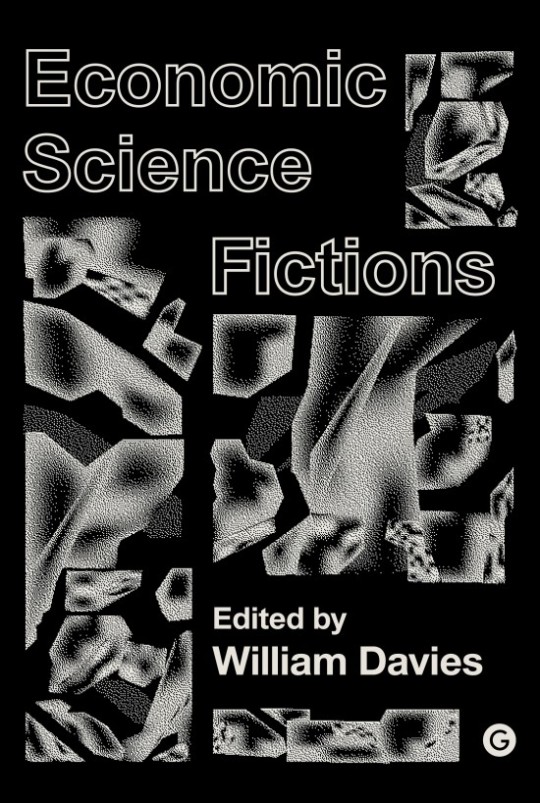

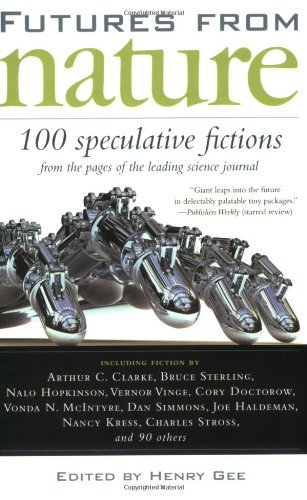
Afterglow: Climate Fiction for Future Ancestors edited by Grist (2023)
Afterglow is a stunning collection of original short stories in which writers from many different backgrounds envision a radically different climate future. Published in collaboration with Grist, a nonprofit media organization dedicated to telling stories of climate solutions, these stirring tales expand our ability to imagine a better world.
Inspired by cutting-edge literary movements, such as Afrofuturism, hopepunk, and solarpunk, Afterglow imagines intersectional worlds in which no one is left behind—where humanity prioritizes equitable climate solutions and continued service to one's community. Whether through abundance or adaptation, reform, or a new understanding of survival, these stories offer flickers of hope, even joy, as they provide a springboard for exploring how fiction can help create a better reality.
Afterglow welcomes a diverse range of new voices into the climate conversation to envision the next 180 years of equitable climate progress. A creative work rooted in the realities of our present crisis, Afterglow presents a new way to think about the climate emergency—one that blazes a path to a clean, green, and more just future.
Magazine: https://grist.org/fix/arts-culture/imagine-2200-climate-fiction-afterglow/
Economic Science Fictions
https://mitpress.mit.edu/9781906897734/economic-science-fictions/
Edited by William Davies (2018)
An innovative new anthology exploring how science fiction can motivate new approaches to economics.
From the libertarian economics of Ayn Rand to Aldous Huxley's consumerist dystopias, economics and science fiction have often orbited each other. In Economic Science Fictions, editor William Davies has deliberately merged the two worlds, asking how we might harness the power of the utopian imagination to revitalize economic thinking.
Rooted in the sense that our current economic reality is no longer credible or viable, this collection treats our economy as a series of fictions and science fiction as a means of anticipating different economic futures. It asks how science fiction can motivate new approaches to economics and provides surprising new syntheses, merging social science with fiction, design with politics, scholarship with experimental forms.
With an opening chapter from Ha-Joon Chang as well as theory, short stories, and reflections on design, this book from Goldsmiths Press challenges and changes the notion that economics and science fiction are worlds apart. The result is a wealth of fresh and unusual perspectives for anyone who believes the economy is too important to be left solely to economists.
Drowned Worlds
edited by Jonathan Strahan (2016)
Review: “The title and the editor both pay tribute to the inspiration of J.G. Ballard’s The Drowned World, that prescient piece of nascent cli-fi first published in 1962. Strahan lauds this “lush, powerful book that tells of a post-apocalyptic world … seen through a romantic haze that hangs over the flooded, inundated ruins of a world laid waste by rising oceans.” Many of the stories in the collection, indeed almost all, share a similar dreamlike or fantastic Ballardian ambience of a world long past the climate change, where remnants of our current civilization often persist just as fantastic fragments.“
Futures From Nature: 100 Speculative Fictions from the pages of the leading science journal
by Henry Gee (2008)
Are aliens really not interested in us at all? Is there a significant health benefit from drinking your own urine? Is loading your personality into a computer the best way to survive the death of the body? Is the death of the body really necessary? Here are a very large number of very small fictions on the subject of the future and what it might be like. The authors include scientists, journalists, and many of the most famous SF writers in the world. Futures from Nature includes everything from satires and vignettes to compressed stories and fictional book reviews, science articles, and journalism, in eight-hundred-word modules. These pieces were originally published in the science journal Nature between 1999 and 2006.
19 notes
·
View notes
Text
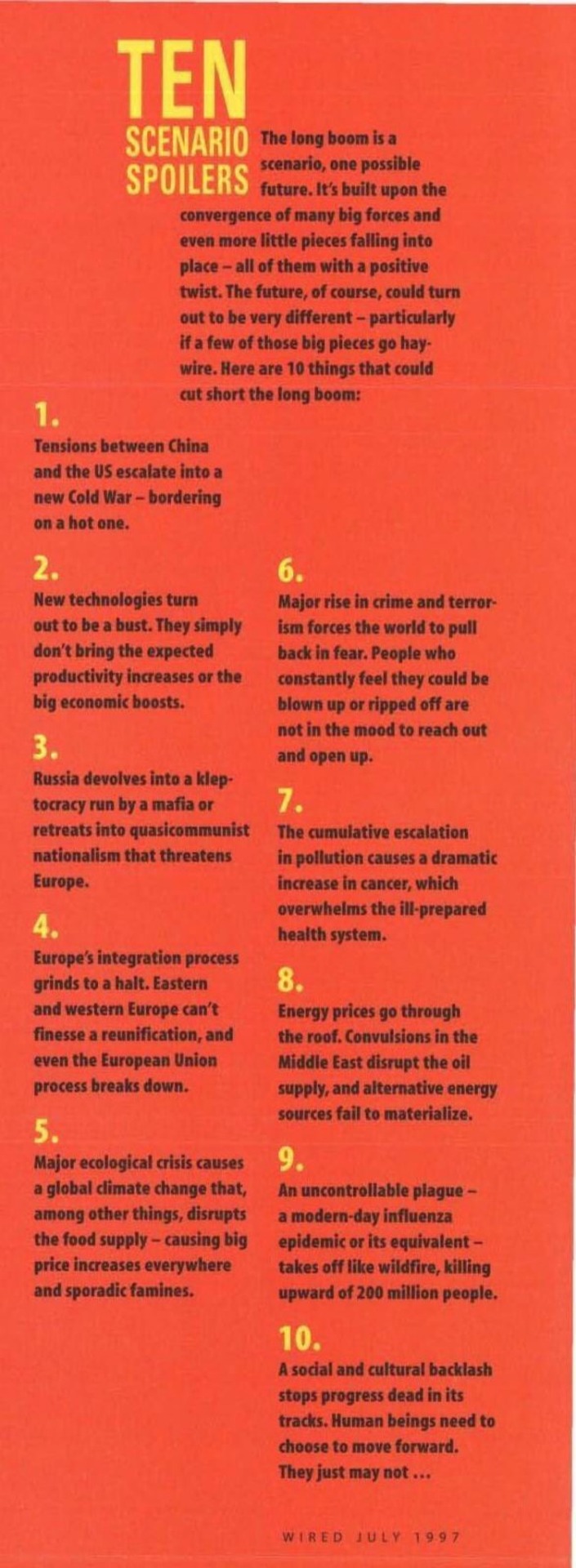
In 1997, 25 years ago, Peter Schwartz and Peter Leyden wrote a Wired article with the title The Long Boom. The point was not to predict the future but to paint a bright image of the future in order to open up our thinking to the possibilities. The list above listed the bad things that could lead us away from the positive scenario described in the article.
And guess what happened?!?
140 notes
·
View notes

